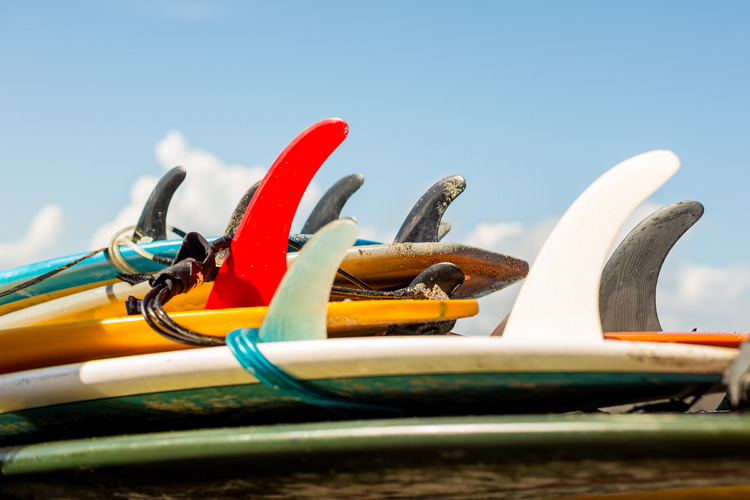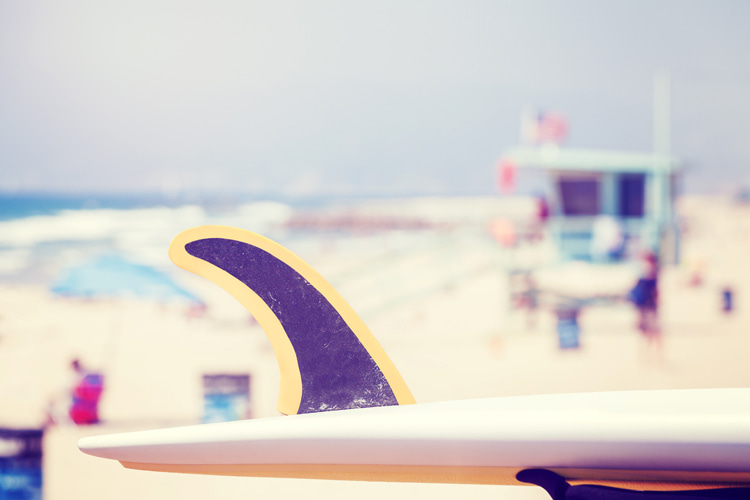Here's a step-by-step guide on how to make a homemade 10-inch single fin for a longboard or funboard.
Commercial surfboard fins are generally expensive, but the truth is that they're hard to make and require a lot of precision technology.
You can always shape it like a board maker, though it can be challenging and time-consuming.
Nevertheless, it is not an impossible mission, and above all, it's fun and can enrich your knowledge of hydrodynamics.
Don't expect to get a perfect fin on your first attempt. The more you practice, the better the outcome.
With the right tools, materials, and a bit of patience, you can create a rideable custom single fin for your longer boards.
Some of the following tools can be replaced by non-electrical hardware.
Read the do-it-yourself tutorial, follow the video, and create your first-ever surf fin.

Tools
- Mixing cups and stir sticks;
- Scissors, utility knife, or rotary cutter;
- Mask/respirator;
- Gloves;
- Rail marking gauge;
- Spiked/ribbed resin roller;
- Squeegee;
- Chisel;
- Tape;
- Sandpaper (80, 120, 220 grit);
- Wet sandpaper;
- Band saw;
- Paint filters;
Materials
- 3/16'' thick clear acrylic sheet;
- 18'' x 15'' layers of 7.5 oz plain weave fiberglass cloth;
- 50 oz polyester/epoxy laminating resin;
- 22 oz hardener;
- 5 oz resin tint pigment;
- Universal mold release;
- Acrylic gloss clear coat;
- Finishing resin (optional);
1. Lamination
- Cut the 36 layers of fiberglass fabric using the rotary cutter;
- Lay the acrylic sheet on a flat surface;
- Tape the acrylic sheet off on all four sides;
- Spray the mold release over the panel;
- Measure out five or six ounces of epoxy, tint it, and run it through the filter;
- Pour 20 ounces of epoxy resin into a container;
- Add two ounces of the epoxy and tint concentrate;
- Mix it up to distribute the color well;
- Pour 9.5 ounces of hardener;
- Mix it for at least two minutes;
- Pour some epoxy directly onto the acrylic surface and disperse it around the panel using the squeegee;
- Remove the excess;
- Lay one sheet of fiberglass and pour more epoxy onto it;
- Place two more layers of cloth and pour the resin, making sure it gets fully saturated and without air pockets;
- Add two more layers and pour the epoxy;
- Use the resin roller to smoothen and even the fiberglass out;
- Repeat the process until you have 16 layers of fiberglass down;
- Let it rest for six hours;
- Pour six ounces of epoxy resin into a container and add the tint concentrate into the mix;
- Pour your new color formula onto the nearly-cured 16 layers board;
- Lay four clear acrylic sheets and apply the correspondent epoxy resin;
- Let the new layers sit overnight;
- Repeat the processes from steps 11-18;
- Take a little bit of clear resin and squeegee that across the weave to help fill in that top layer;
2. Shaping
- Work a chisel underneath the fiberglass board so that you can bend the acrylic and detach it;
- Lay the board on a flat surface;
- Mark off your fin templates;
- Use a blade on the band saw that is appropriate for fiberglass;
- Cut off the template;
- Clean up the perimeter by hand with a sanding block or some sandpaper. You want a nice square perimeter so that you know that when you're shaping your fin, you're not coming out of that true shape;
- Drill out for the pin on the back or front of the fin, depending on your template. You can use a 3/16'' x 9/16'' stainless steel spring pin;
- Taking the base down close to the final thickness - around one inch in diameter - using a router table;
- Start sanding the fin's starboard trailing edge using a 60-grit silicon carbide sanding pad;
- Make even passes to try to bring out the fiberglass contour lines and work them about two-thirds of the way across the trailing edge of the fin;
- Try to keep an even bevel and push that all the way forward, maintaining a pretty consistent width;
- Now, take some heavily angled passes on the leading edge, leaving a little bit of margin on either side of our pencil line, wrap it around, and try to blend the leading and trailing edges together to develop a parabolic curve like an airplane wing;
- Flip the fin and take down the trailing edge of the port side;
- Be cautious - you don't want to blow into your base too much, but you also want to shape it enough;
- By now, the rough shape should be looking good;
3. Sanding
- Switch to the 120-grit silicon carbide sanding pad;
- Starting sanding again on the starboard side, just pushing it a little further and smoothing out any of the undulations that shouldn't be there - you'll begin to see the colors come up even more;
- Switch to the soft flex 220 grit pad and pass it around the whole surface area;
- Take a strip of a 60-grit sanding disc that doesn't get used to round the leading edge over and spend some time there making sure that it's symmetrical and parabolic;
- Now, work on your trailing edge to a finer taper with 120-grit sandpaper, making sure it doesn't get too sharp;
- Continue working sandpaper on the base of the fin and all edges and surfaces using 220-grit sandpaper;
- Make sure the base is going to fit in the fin box. Test it on a loose box, in the surfboard, or measure it using calipers;
- Insert the stainless steel spring pin;
- Drill a hole for the hardware using a 3/16'' drill bit;
- Rinse the fin with fresh water to remove the dust;
4. Finishing
- Sand the whole fin for one minute using 320-grit wet sandpaper;
- Repeat the process with 320-grit wet sandpaper;
- Clean the fin with denatured alcohol;
- Spray finish it;
- Install your custom-made surfboard fin and surf;
